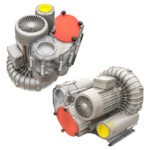With so many types and brands of industrial vacuum pumps on the market today, a wide range of issues can arise that can negatively impact your business.
In this post, we examine the five most common problem areas and how to resolve them – whether repairing or replacing the pumps is necessary, or if less drastic solutions will work.
1. UNMATCHED VOLTAGE
A common issue encountered by users of all types of vacuum pumps is failing to ensure proper wiring of the motor to match the incoming voltage. This can damage or burn up the motor.
The motor wiring is determined by the incoming power supply. Once the incoming power is verified, the voltage ratings can be found on the motor tag (not to be confused with the pump tag).
Depending on the motor, the wiring can be set for multiple voltages. Three phase motors typically have two configurations: high voltage or low voltage. The correct configuration for these settings can be found inside the motor box cover or on the motor tag. If not present, contact Becker Support to obtain this information.
Rotation of the unit is crucial. This can be checked after the wiring has been installed and confirmed for the proper voltage by “bump starting” the unit and watching the fan for rotation.
Arrows to indicate proper rotation direction can be found on the outside protective cover or the motor flange. In a 3-phase setting, the direction of rotation can be changed by swapping two of the incoming leads. When bump starting any unit be sure the inlet and outlet of the pump are open to ambient air to allow the pump to rotate without restriction.
2. TRIPPING THE BREAKER
If a unit is continuously tripping a breaker so that the pump won’t turn on, further troubleshooting is required.
Start by checking that the breaker is rated for the proper values compared to the ones on the motor tag. For example, if a 20 amp breaker is installed but the motor is rated for 25 amps the breaker will overload and trip. Adjust the breaker for proper range and support.
If the pump has been in operation for some time and tripping is a new occurrence, first lockout/tagout the pump/motor to cut power to the motor.
Next, open the pump and inspect the working chamber for potential metal-to-metal contact, broken vanes, or other obstructions that are generating more resistance and causing a spike in amp draw.
Note: This step will vary depending on the pump type, if unsure how to access the working chamber for your specific model please contact Becker Support.
3. LOSS OF VACUUM/PRESSURE
A loss in vacuum or pressure can often be attributed to lack of pump maintenance. If the inlet filters are not periodically cleaned and/or replaced, the pump can starve of proper airflow, resulting in performance loss and potential failure.
To quickly check that your filters are clean and clear, hold a flashlight on the outside of the filter and look to see how much, if any, visible light shines through. If little to no light is visible after blowing the filter out, it’s time to change the filter. Additional technical options to determine a fliter’s health are available—contact Becker Support for more information.
A loss in pump performance can also be caused by sticking or worn vanes. To check this, start by removing and measuring the vanes to determine if they have worn past their minimum height tolerance. Inspect each vane for chips, breaks, abnormal wear, and cupping.
The maintenance sticker attached to the top of your vacuum pump will show the minimum specs for the vanes specific to your model.
Cupping can be found when laying all the vanes on top of one another and observing the end view. If visible light or “bowing” can be seen between the vanes, one or more may be beginning to cup. This can weaken the vanes so much that eventually, they break, resulting in a seized pump.
Vane cupping is only caused from overheating—please consult Becker’s Service Team for corrective actions immediately.
Another potential cause for loss in pump performance is sticking vanes that will not drop from the rotor. Contamination from the application or over-greasing can cause the vanes to stick. In an oil-lubricated pump, the vanes will stick if the oil becomes too thick. Lack of proper oil flow will cause lubricated vanes to delaminate and swell so that they stick in the rotor slots.
Cleaning out thick oil or running flushing oil through the pump can help to free up vanes and improve oil flow. In dry vane pumps, buildup of carbon vane dust in the rotor slots can cause vanes to stick. Compressed air and 220 grit sandpaper can be used to gently remove vane dust from the rotor slot.
4. OIL MISTING FROM THE EXHAUST
Misting oil from the exhaust port while the unit is running could be caused by several contributing factors.
First, Becker’s oil-lubricated pumps are best run at the deepest vacuum level they can reach. If your oil-lubricated pump is running at less than 20”Hg, there will be an increase in exhaust pressure as more ambient air is present in the pump. This will cause more oil to leave the pump. Ensure all connections are tight and not leaking on the inlet portion of the pump/application. Measure the vacuum level at the inlet of the pump and aim for a vacuum level of 20-29”Hg.
Second, an inspection of the oil separators should be done. Over time, oil will accumulate in the separators and they can become saturated. These filters collect oil particles from the exhaust air stream. If they become saturated, they cannot collect oil and it will be blown out of the exhaust port instead. The oil separator should be changed regularly, just like a normal air filter.
Third, check the float chamber. All oil-lubricated models will have a small “scavenger line” connecting the float chamber to either the inlet or B-side end shield. This chamber is located just below the oil separators in the exhaust of the pump.
If this line and/or the chamber becomes clogged or contaminated it will starve the working chamber of fresh oil to properly lubricate the vanes, and the float chamber to overfill with oil. The exhaust pressure traveling across this float chamber will cause oil to mist from the exhaust or just simply leak oil from the exhaust port/cover.
5. CHATTERING/SCREECHING SOUNDS
A question about noise often arises when customers initially install their pumps, especially dry vane pumps.
On initial startup, it is common to hear a “clicking” sound when the vanes drop out of their rotor slots due to centrifugal force and contact with the cylinder walls, especially at lower speeds. In most cases this is normal.
Additionally, when new vanes are installed or a freshly rebuilt unit is run for the first time, a very high-pitched screeching sound is sometimes generated. This noise is due to the vanes breaking in. Allow the pump to run for 24-48 hours. If the noise continues, please consult the Becker Service Team.
To help reduce or mitigate the noise issue when rebuilding a pump or even exchanging vanes for a new set, be sure to clean and clear out all vane debris from the previous set. Using a clean rag, brake cleaner, and compressed air, thoroughly clean the cylinder walls. If the vanes are trying to mesh to a contaminated/dirty cylinder the noise will take longer to go away and may never stop.
If the pump has been in operation for some time and you notice a new noise or an increase in noise or clicking while in operation, it’s time to check the filters, bearings, and vanes.
With older pumps, the cylinder wall will need to be inspected for “washboarding” – look for ripples or waves along the wall that form from extended use. Washboarding will cause the vanes to skip as they scrape across the cylinder walls, increasing heat and noise and a loss of vane life. Once washboarding begins the only fix is replacing the cylinder.
TIPS FOR PREVENTING VACUUM PUMP PROBLEMS

These five common problems with vacuum pumps can significantly impact the efficiency and reliability of your industrial processes. Any of these issues will undoubtedly disrupt the process with downtime that could be costly.
Here are some tips for how to get ahead of disruptions in your operations:
IDENTIFY POTENTIAL PROBLEMS QUICKLY
An increase in the running temperature of the pump can often indicate an issue that should be checked. The heat could be due to metal contact within the working chamber, broken vanes, wash boarding, bearing failures, oil viscosity, etc.
An increase in noise or vibration, or an increase in amps, should not be ignored. Contact the Service Center for further troubleshooting assistance.
The two most common causes of failure across any type of vacuum/pressure pump are ingestion of contaminants from the application and running the unit for too long on a clogged or restricted filter.
PERFORM PREVENTATIVE MAINTENANCE
Another main cause are gaps in the preventative maintenance schedule based on use and application. Follow the manufacturer’s recommendations, but recognize that these must be tailored to your specific needs to ensure you get the most out of your pump for years to come.
Periodically checking the filters, measuring the vanes, checking oil level and condition, and installing the proper external accessories to help protect the pump will all aid in extending its life.
Leaks in vacuum pumps or vacuum systems often can be attributed to a lack of tight and secure connections within the plumbing of the system.
Also, some specific Becker Pump models (KVT, DVT, KDT) have an O ring located around the collar of the vacuum relief valves that over time can dry rot, causing a leak directly at the valve. Your contact at Becker can assist you with the recommended guidelines as well as provide maintenance kit part numbers and pricing for your specific Becker model.
DECIDING BETWEEN REPAIR AND REPLACEMENT
Some customers will opt to have their old model rebuilt to use as a backup and put a new pump into operation. Due to extensive damage, some may be scrapped or sent back as is and a new one purchased because the cost of a new pump is less than rebuilding the old one.
SUPPORT FOR ALL YOUR VACUUM PUMP NEEDS
Becker currently offers mobile repair services based out of two locations. We also have a full-service center where you can send your pump for evaluation and repair by factory-trained technicians. We support warranty evaluations, total rebuilds, maintenance, and everything in between.
Our Technical Department is dedicated to helping you with any application-based solutions. For those who want to learn more, Becker offers training courses from Basics to Maintenance, to full in-depth repair.
And, if you’re in the market for a high-quality vacuum pump for your industrial application, Becker has you covered. We deliver a variety of customer-specific market solutions for different applications within each market. Click below to learn more about the solutions we offer for your industry.




